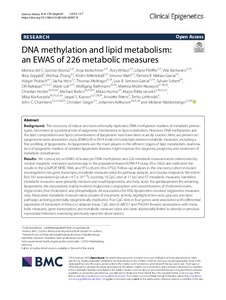DNA methylation and lipid metabolism: an EWAS of 226 metabolic measures
Ala-Korpela Mika; Roden Michael; Sebert Sylvain; Jarvelin Marjo-Riitta; Peters Annette; Serrano-Garcia Luis R.; Loh Marie; Horn Sacha; Seppälä Ilkka; Raitakari Olli; Kretschmer Anja; Herder Christian; Rathmann Wolfgang; Kettunen Johannes; Wahl Simone; Lehtimäki Terho; Müller-Nurasyid Martina; Hurme Mikko; Kooner Jaspal S.; Karhunen Ville; Pfeiffer Liliane; Matias-Garcia Pamela R.; Gomez-Alonso Monica del C.; Meitinger Thomas; Wilson Rory; Waldenberger Melanie; Mittelstraß Kirstin; Prokisch Holger; Chambers John C.; Gieger Christian; Zhang Weihua
https://urn.fi/URN:NBN:fi-fe2021042827365
Tiivistelmä
Background: The discovery of robust and trans-ethnically replicated DNA methylation markers of metabolic phenotypes, has hinted at a potential role of epigenetic mechanisms in lipid metabolism. However, DNA methylation and the lipid compositions and lipid concentrations of lipoprotein sizes have been scarcely studied. Here, we present an epigenome-wide association study (EWAS) (N = 5414 total) of mostly lipid-related metabolic measures, including a fine profiling of lipoproteins. As lipoproteins are the main players in the different stages of lipid metabolism, examination of epigenetic markers of detailed lipoprotein features might improve the diagnosis, prognosis, and treatment of metabolic disturbances.
Results: We conducted an EWAS of leukocyte DNA methylation and 226 metabolic measurements determined by nuclear magnetic resonance spectroscopy in the population-based KORA F4 study (N = 1662) and replicated the results in the LOLIPOP, NFBC1966, and YFS cohorts (N = 3752). Follow-up analyses in the discovery cohort included investigations into gene transcripts, metabolic-measure ratios for pathway analysis, and disease endpoints. We identified 161 associations (p value < 4.7 x 10-10), covering 16 CpG sites at 11 loci and 57 metabolic measures. Identified metabolic measures were primarily medium and small lipoproteins, and fatty acids. For apolipoprotein B-containing lipoproteins, the associations mainly involved triglyceride composition and concentrations of cholesterol esters, triglycerides, free cholesterol, and phospholipids. All associations for HDL lipoproteins involved triglyceride measures only. Associated metabolic measure ratios, proxies of enzymatic activity, highlight amino acid, glucose, and lipid pathways as being potentially epigenetically implicated. Five CpG sites in four genes were associated with differential expression of transcripts in blood or adipose tissue. CpG sites in ABCG1 and PHGDH showed associations with metabolic measures, gene transcription, and metabolic measure ratios and were additionally linked to obesity or previous myocardial infarction, extending previously reported observations.
Conclusion: Our study provides evidence of a link between DNA methylation and the lipid compositions and lipid concentrations of different lipoprotein size subclasses, thus offering in-depth insights into well-known associations of DNA methylation with total serum lipids. The results support detailed profiling of lipid metabolism to improve the molecular understanding of dyslipidemia and related disease mechanisms.
Kokoelmat
- Rinnakkaistallenteet [27094]
